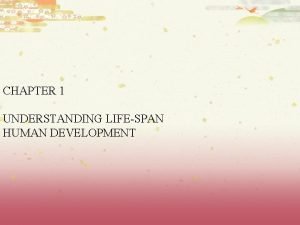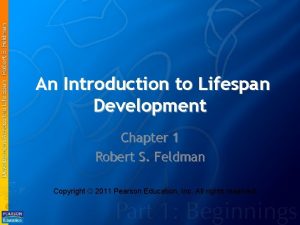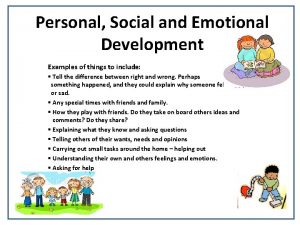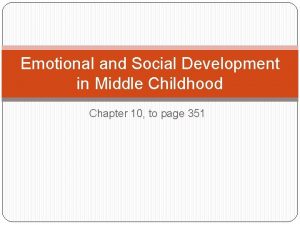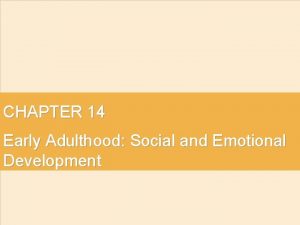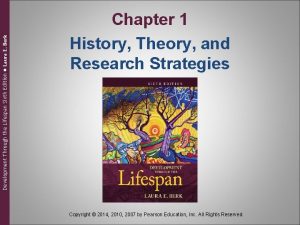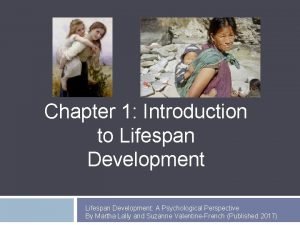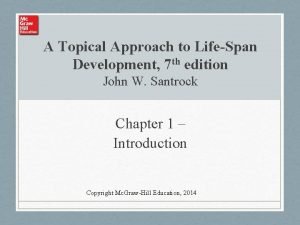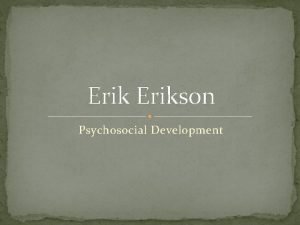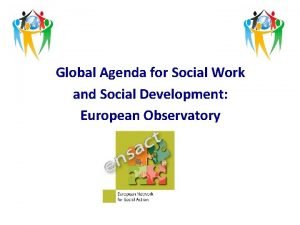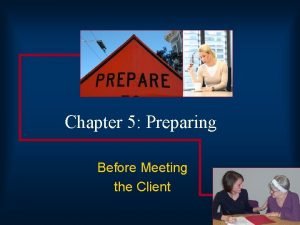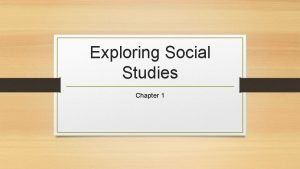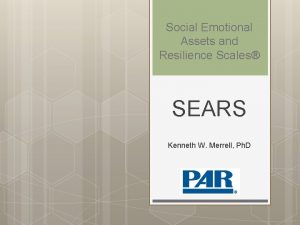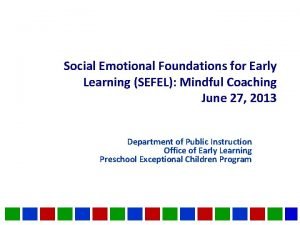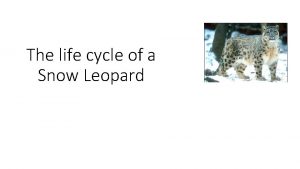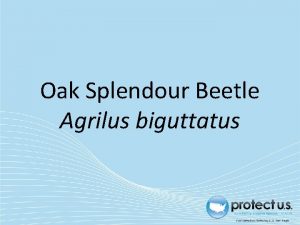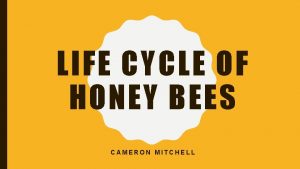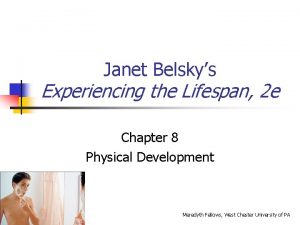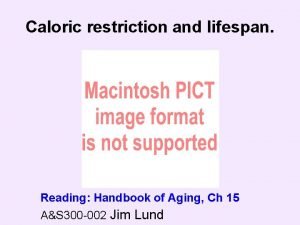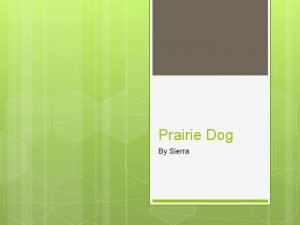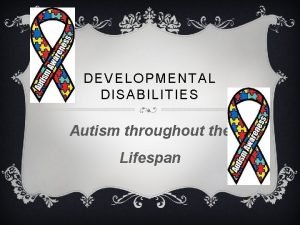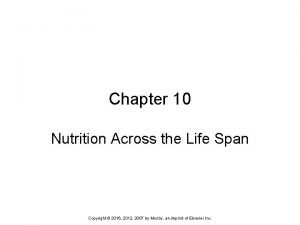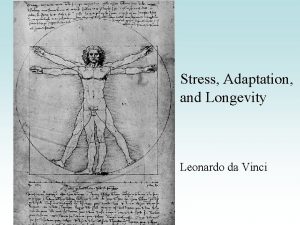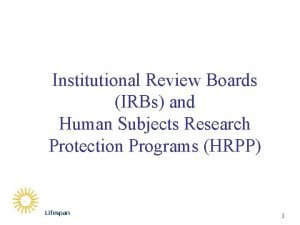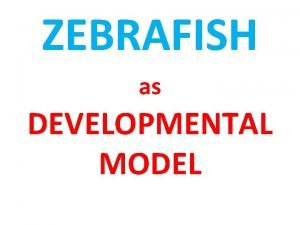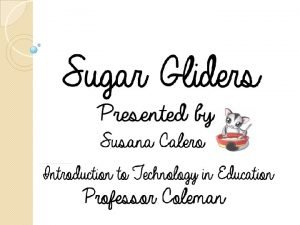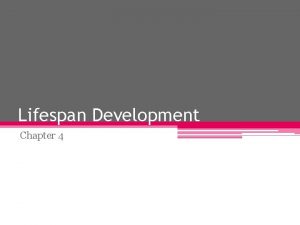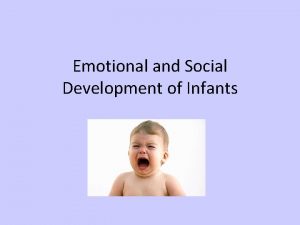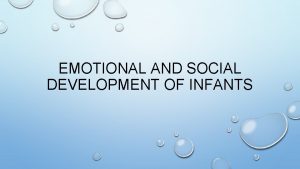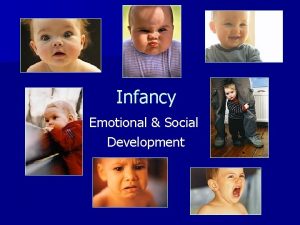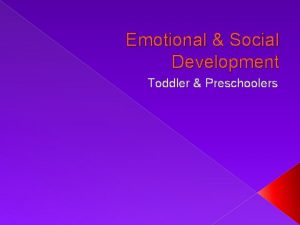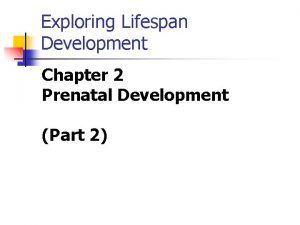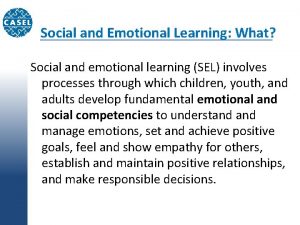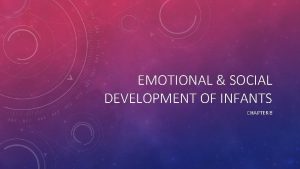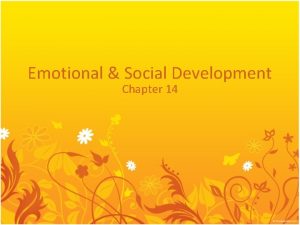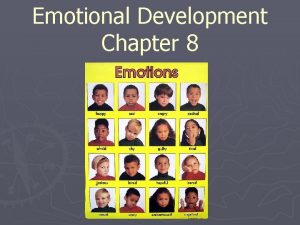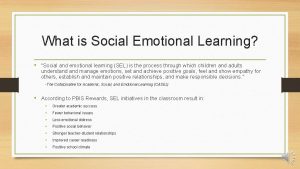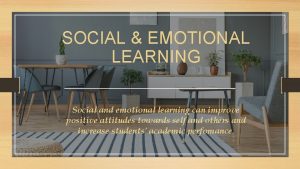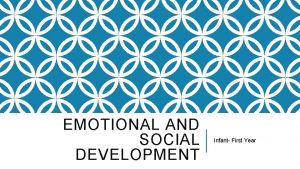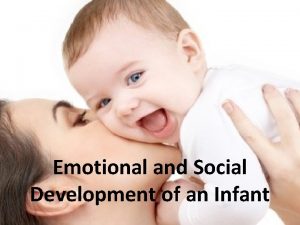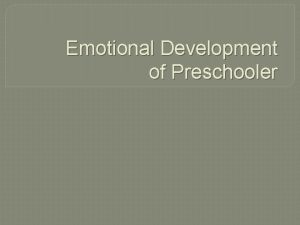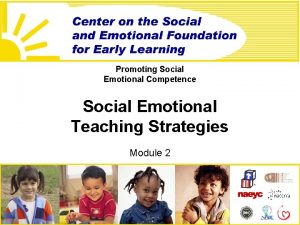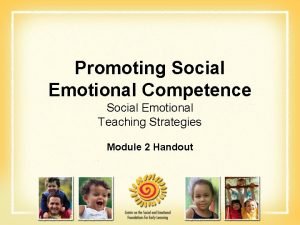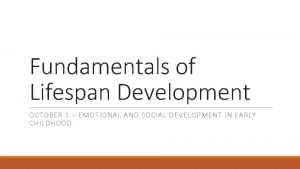Exploring Lifespan Development Chapter 8 Emotional and Social













































- Slides: 45

Exploring Lifespan Development Chapter 8 Emotional and Social Development in Early Childhood This multimedia product and its contents are protected under copyright law. The following are prohibited by law: n Any public performance or display, including transmission of any image over a network; n Preparation of any derivative work, including the extraction, in whole or in part, of any images; n Any rental, lease, or lending of the program. Copyright © 2011 Pearson Education, Inc. All rights reserved.

Erikson’s Theory: Initiative versus Guilt Initiative n n Guilt new sense of purposefulness eagerness to try new tasks, join activities Imitation & play permits trying out new skills strides in conscience development n n overly strict superego, or conscience, causing too much guilt related to excessive: n n n threats criticism punishment Copyright © 2011 Pearson Education, Inc. All rights reserved.

Self-Understanding Emerging language skills enable children to discuss inner mental states. n Self-awareness and self -concept increase together. n Copyright © 2011 Pearson Education, Inc. All rights reserved. Absolute Family

Self-Concept n Based on observable characteristics: n n n appearance possessions behavior Typical emotions and attitudes n Asserting rights to objects n n (“Mine!”) helps define boundaries of self. Copyright © 2011 Pearson Education, Inc. All rights reserved. ©Jenkedco/Dreamstime. com

Self-Esteem Judgments we make about our own worth n Feelings about those judgments n Includes: n global appraisal n judgments of different aspects of self n Photodisc Copyright © 2011 Pearson Education, Inc. All rights reserved.

Developing Emotional Competence Emotional understanding improves n Emotional selfregulation improves n More self-conscious emotions (shame, guilt) and empathy n Photodisc Copyright © 2011 Pearson Education, Inc. All rights reserved.

Emotional Understanding n Preschoolers judge: n n causes of emotions consequences of emotions behavioral signs Parents, siblings, and play contribute to understanding. Copyright © 2011 Pearson Education, Inc. All rights reserved. Absolute Family

Emotional Self-Regulation By age 3– 4, know strategies for adjusting emotional arousal n Effortful control important n Affected by parents, temperament n Absolute Family Copyright © 2011 Pearson Education, Inc. All rights reserved.

Self-Conscious Emotions Shame Embarrassment Guilt Envy Pride Absolute Family Preschoolers depend on adult feedback to know when to experience these emotions. n Culture also influences n Copyright © 2011 Pearson Education, Inc. All rights reserved.

Sympathy and Empathy Sympathy n Empathy feeling of concern or sorrow for another’s plight n feeling same or similar emotions as another person n n complex mix of cognition and emotion must detect emotions, take other’s perspective Copyright © 2011 Pearson Education, Inc. All rights reserved.

Individual Differences in Empathy n Temperament n n n sociable, assertive, good at emotional regulation more likely to display sympathy and prosocial behavior Parenting n warm, sensitive parents who encourage emotional expressiveness Copyright © 2011 Pearson Education, Inc. All rights reserved. Absolute Family

Peer Sociability in Play Nonsocial activity n n n Parallel play n Social interaction n n unoccupied, onlooker behavior solitary plays near other children with similar materials does not try to influence them associative play cooperative play Copyright © 2011 Pearson Education, Inc. All rights reserved.

Cognitive Play Categories Functional play n simple, repetitive motor movements with or without objects n creating or constructing something n acting out everyday and imaginative roles n Constructive play Make-believe play Copyright © 2011 Pearson Education, Inc. All rights reserved.

Early Childhood Friendships Someone “who likes you, ” plays with you, shares toys n Friendships change frequently. n Friends more reinforcing, emotionally expressive than nonfriends n n n Friendship provides social support. The ease in acquiring friends predicts later achievement behaviors. Copyright © 2011 Pearson Education, Inc. All rights reserved.

Perspectives on Moral Development Psychoanalytic n Freud: superego and guilt today: induction, empathy-based guilt Social learning n modeling moral behavior n children as active thinkers about social rules n Cognitivedevelopmental Copyright © 2011 Pearson Education, Inc. All rights reserved.

Good Characteristics of Good Models of Moral Behavior Warmth and responsiveness n Competence and power n Consistency between words and behavior n Absolute Family Copyright © 2011 Pearson Education, Inc. All rights reserved.

Punishment in Early Childhood Frequent and harsh physical punishment has undesirable and negative side effects. Alternatives to harsh punishment How parents can increase the effectiveness of punishment n n n time out withdrawing privileges positive discipline consistency warm parent–child relationship explanations Copyright © 2011 Pearson Education, Inc. All rights reserved.

Positive Discipline ü ü ü Use transgressions as opportunities to teach. Reduce opportunities for misbehavior. Provide reasons for rules. Have children participate in family duties and routines. Try compromising and problem solving. Encourage mature behavior. Copyright © 2011 Pearson Education, Inc. All rights reserved.

Moral Imperatives, Social Conventions, and Personal Choice Moral imperatives Social conventions Matters of personal choice n actions that protect people’s rights and welfare n customs determined solely by social consensus n do not violate rights not socially regulated up to the individual n n Copyright © 2011 Pearson Education, Inc. All rights reserved.

Types of Aggression n Proactive/Instrumental n n meant to help the child get something he or she wants Reactive/Hostile n meant to hurt someone else Copyright © 2011 Pearson Education, Inc. All rights reserved. ©Cheryl Casey/Dreamstime. com

Types of Hostile Aggression Type Physical Verbal How the Harm Is Caused n physical injury either n threats of physical aggression name-calling teasing always direct social exclusion malicious gossip friendship manipulation either n n n Relational Direct or Indirect? n n Copyright © 2011 Pearson Education, Inc. All rights reserved.

Sources of Aggression n Individual differences n n n Family n n n gender temperament harsh, inconsistent discipline cycles of discipline, whining/giving in Media violence Copyright © 2011 Pearson Education, Inc. All rights reserved.

Dangers of Media Violence n n n Most television shows contain violent scenes. Short-term problems with parents, peers Long-term link to aggressive behavior Sparks hostile thoughts and behaviors “Hardens” children to aggression Copyright © 2011 Pearson Education, Inc. All rights reserved.

Helping Control Aggression ü ü ü Pair commands with reasons. Avoid “giving in. ” Avoid verbal insults and physical punishment. n n ü ü ü time-out withdraw privileges Engage in social problem-solving training. Reduce family stress. Regulate exposure to media violence. Copyright © 2011 Pearson Education, Inc. All rights reserved.

Gender Stereotypes in Early Childhood n Begin around 18 months n n n men: sharp, rough women: soft, round Strengthen and become rigid through early childhood n n divide toys, clothing, tools, jobs, games, emotions, and more by gender One-sided judgments are a joint product of gender stereotyping in environment and cognitive limitations. Copyright © 2011 Pearson Education, Inc. All rights reserved.

Influences on Gender Typing n Genetic n n n Environmental n n Rubber. Ball Productions evolutionary adaptiveness hormones n n family teachers peers broader social environment Copyright © 2011 Pearson Education, Inc. All rights reserved.

Theories of Gender Identity Social learning Cognitivedevelopmental Gender schema n Behavior leads to gender identity. n Self-perceptions (gender constancy) come before behavior. n combines social learning and cognitive-developmental theories Copyright © 2011 Pearson Education, Inc. All rights reserved.

Reducing Gender Stereotyping Delay exposure to stereotyping. n Limit traditional family gender roles. n Provide nontraditional models. n Encourage flexible beliefs. n Family Life Copyright © 2011 Pearson Education, Inc. All rights reserved.

Child-Rearing Styles Authoritative n Authoritarian n Permissive n Uninvolved n ©Rohit Seth/Dreamstime. com Copyright © 2011 Pearson Education, Inc. All rights reserved.

Characteristics of Child-Rearing Styles Acceptance Involvement Control Autonomy Authoritative high adaptive appropriate Authoritarian low high low Permissive high too low or too high low high Uninvolved low low indifference Copyright © 2011 Pearson Education, Inc. All rights reserved.

Forms of Discipline Reinforcement and Punishment n Children usually learn from reinforcement for good behavior versus punishment n External reinforcers may be tangible (candy) and intangible (smile) n Child must see it as rewarding n Consistent n Eventually, move to internal reward- sense of accomplishment and pride n Also denial of privileges can be used

Forms of Discipline Punishment, if consistent, immediate, and clearly tied to the offense, may be effective. Administer calmly, in private, aimed at eliciting compliance, not guilt, along with short explanation Corporal punishment Use of physical force with intention of causing a child to experience pain, not for injury, purpose of correction or control of child’s behavior.

Forms of Discipline Spanking, hitting, pinching, shaking Mostly used with aggressive children; hard to manage child; characteristics of a genetic basis. Must be loving parents and not result in serious injury However, evidence suggests that it has serious negative consequences and should not be used!

Power Assertion, Induction, and Withdrawal of Love Power Assertion: intended to stop undesirable behavior though physical or verbal enforcement of parental control; includes demands, threats, withdrawal of privileges, spankings. Generally induces fear. Least effective. Induction: encourage desirable behavior (or discourage undesirable behavior) by reasoning with child; includes setting limits, demonstrating logical consequences, explaining, discussion, getting ideas from child about what is fair. Most effective.

Power Assertion, Induction, and Withdrawal of Love: may include ignoring, isolating, showing dislike for child. Psychological Aggression n Verbal attacks that may result in psychological harm; yelling, screaming, swearing, threatening to spank, threatening to kick out of house. Occurs in at least 2/10 households, likely 4 -5/10 n 20% parents of toddlers engage in n 50% among parents of teens

Parenting Styles Authoritarian n High on control but low on responsiveness n Characterized by low warmth n Little positive involvement with their children n Set rigid rules n Discipline harshly n Expect obey because of parental authority

Parenting Styles Authoritative n Show warm, responsive involvement n Set appropriate and clear standards n Communicate openly n Provide rationale for rules n Show respect for children’s rights and opinions n Encourage autonomy and independence, resulting in social competence

Parenting Styles Permissive-Indulgent n Highly warm and responsive n Place few demands or expectations n Rules that exist are not clearly communicated or enforced so children left to make own decisions and regulate own behavior

Parenting Styles Permissive-Indifferent n Leave children alone to make their own decisions and control own behavior n Place few demands, neglectful n Appearing emotionally detached, show little or no involvement in their children’s lives

Consequences of Parenting Styles (Baumrind) Authoritative: Self-reliance Social responsibility Higher levels of achievement Authoritarian: Social incompetence Anxiety about social comparison Failure to show initiative Poor communication skills Lower school performance Lower self-esteem

Consequences of Parenting Styles (Baumrind) Permissive-indulgent: n Expect to get their own way n Show little respect for others n Never learn to control their own behavior n Lower school performance Permissive-Indifferent: n Social incompetence n Lack of self-control n Lower school performance However, no one right way to raise children. Cause-effect not demonstrated (e. g. , parent style causing child’s incompetence- consider innate factors, temperament)

Child Maltreatment Physical abuse n Sexual abuse n Neglect n Emotional abuse n ©Jennifer Russell/Dreamstime. com Copyright © 2011 Pearson Education, Inc. All rights reserved.

Factors Related to Child Maltreatment Parent characteristics n Child characteristics n Family characteristics n Community n Culture n ©Photobunnyuk/Dreamstime. com Copyright © 2011 Pearson Education, Inc. All rights reserved.

Consequences of Child Maltreatment n Emotional problems n poor emotional selfregulation depression n n School, learning problems Brain damage Adjustment difficulties n n aggression peer problems substance abuse delinquency Copyright © 2011 Pearson Education, Inc. All rights reserved.

Preventing Child Maltreatment Training high-risk parents n Social supports for families n n n Parents Anonymous home visitation Copyright © 2011 Pearson Education, Inc. All rights reserved.
 Physical development
Physical development Exploring lifespan development chapter 1
Exploring lifespan development chapter 1 Sociocultural graded influences
Sociocultural graded influences Openstax
Openstax Ul guidance counselling
Ul guidance counselling Personal social examples
Personal social examples Middle childhood social and emotional development
Middle childhood social and emotional development Middle age
Middle age Emotional development during early adulthood
Emotional development during early adulthood Socioemotional development in late adulthood
Socioemotional development in late adulthood Development through the lifespan 6th edition
Development through the lifespan 6th edition Discontinuous development psychology
Discontinuous development psychology A topical approach to lifespan development
A topical approach to lifespan development Lifespan development third edition
Lifespan development third edition Lifespan development third edition
Lifespan development third edition Autonomy vs shame and doubt example
Autonomy vs shame and doubt example Global agenda for social work and social development
Global agenda for social work and social development Slidetodoc.com
Slidetodoc.com Adulthood social development
Adulthood social development Preparatory reviewing social work
Preparatory reviewing social work Exploring social studies lesson 1 thinking like a historian
Exploring social studies lesson 1 thinking like a historian Social emotional assets and resilience scales
Social emotional assets and resilience scales Emotional health and wellbeing framework
Emotional health and wellbeing framework Social and emotional foundations for early learning
Social and emotional foundations for early learning Life cycle of a leopard
Life cycle of a leopard Pelican gulper
Pelican gulper Lifespan of fruit to be used in a caramel petit fours
Lifespan of fruit to be used in a caramel petit fours Splendour beetle lifespan
Splendour beetle lifespan Honeybee lifespan
Honeybee lifespan Ponce de leon nationality
Ponce de leon nationality Janet belsky
Janet belsky Henry hudson
Henry hudson Lifespan of every animal
Lifespan of every animal The developing person through the life span 9th edition
The developing person through the life span 9th edition Prairie dog characteristics
Prairie dog characteristics Autism lifespan
Autism lifespan Chapter 10 nutrition
Chapter 10 nutrition Eagle lifespan 70 years
Eagle lifespan 70 years Da vinci lifespan
Da vinci lifespan Lifespan irb
Lifespan irb Fun facts about henry hudson
Fun facts about henry hudson Portuguese man of war habitat
Portuguese man of war habitat Lifespan of platelets
Lifespan of platelets La vecchio
La vecchio Life cycle of zebrafish
Life cycle of zebrafish Sugar glider age chart
Sugar glider age chart

